Bulletin – March 2011 Developments in Global Food Prices
- Download the article 259KB
Abstract
Global food prices have increased significantly since the early 2000s, reversing the long-run trend decline in relative food prices over previous decades. A range of supply disruptions in key food-producing countries have contributed to higher food prices, along with strong demand from developing countries as per capita incomes rise and consumption patterns change. Rising commodity prices are leading to higher headline consumer price inflation in many countries though, at this stage, core measures of inflation remain relatively contained.
Introduction
The international prices of many agricultural commodities have increased significantly over the past two years. After falling sharply during the global financial crisis, the IMF Food Price Index has increased by 50 per cent since the end of 2008 and is now above its earlier peak in mid 2008. Supply disruptions have been an important factor behind the recent rise in the relative price of food, with unfavourable weather conditions in a number of key food-producing countries weighing on production – particularly for crops such as wheat, sugar, corn and soybeans. More generally, strong demand for agricultural commodities has also contributed to rising food prices since the early 2000s, reversing the long-run trend decline in relative food prices over previous decades (Graph 1). High population growth and rising living standards in developing economies are leading to an increase in protein consumption, which – through demands on land use and demand for feed grains – is contributing to broad-based pressure on food prices.
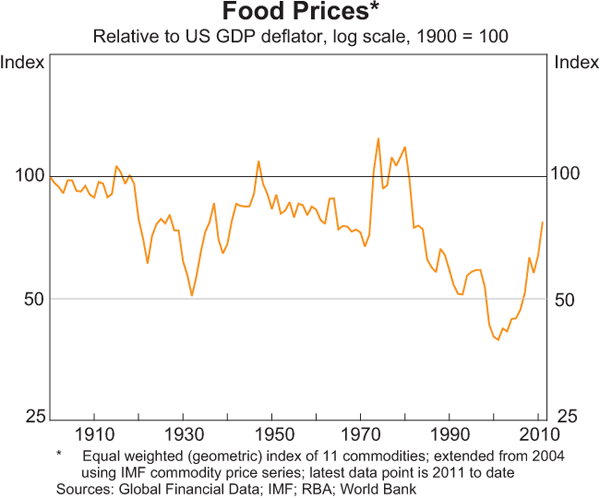
In many countries, rising agricultural commodity prices are leading to higher consumer price inflation more generally. The effect of higher global food prices on consumer price inflation tends to be greater in developing countries, where food makes up a larger share of households' consumption basket. Some countries have taken direct measures to contain domestic food price inflation and increase food supply, including imposing trade restrictions and penalties for speculation and hoarding, increasing the supply of fertiliser, and improving supply-chain logistics. This article discusses the demand and supply factors underpinning the recent rise in global food prices and implications for inflation.
Demand-side Developments
Demand for rural commodities has been strong, particularly from rapidly growing developing countries. High population and income growth in developing countries – where the income elasticity of food demand is typically higher than in developed countries – has supported demand for grains, and increasingly for protein sources such as meat and dairy products.
After slowing through the 1960s to mid 1990s, trend growth in global grain consumption has picked up to around 2 per cent in recent years, with China, Brazil and India accounting for more than one-third of this growth (Graph 2). While trend growth in production has generally kept pace with demand growth in recent years, the United States Department of Agriculture (USDA) estimates that grain production will decline by around 2 per cent in 2010/11. As a result, the level of grain stocks relative to consumption – most notably for corn and rice – will remain at relatively low levels compared with that recorded in the 1980s and 1990s. China's domestic grain stocks are especially low, and the volume of Chinese imports of grain increased by 28 per cent in 2010.
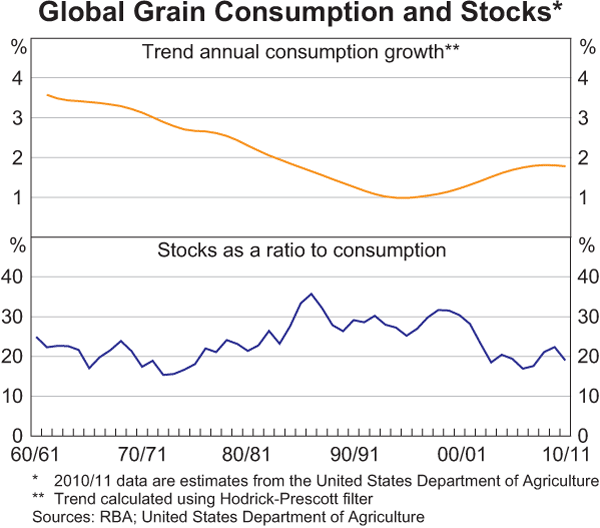
Population growth can be expected to boost food demand over coming decades, but at a slower pace than in recent decades (Graph 3). The United Nations' central projections of world population suggest that growth will slow from an average of 1.2 per cent over the past decade to 0.3 per cent by 2050. However, population growth in developing countries is expected to remain higher than in developed economies and food demand should increase as living standards in these countries improve.
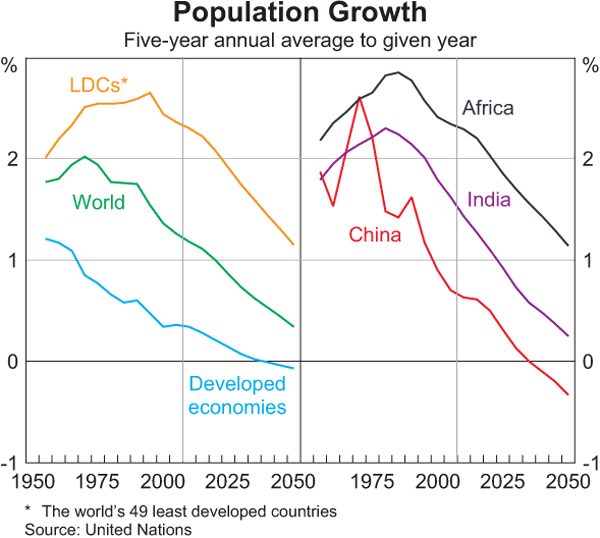
Food consumption patterns tend to change as per capita incomes rise. Specifically, increasing income is often associated with stronger demand for protein sources, such as livestock and dairy products, and a shift away from grains. For example, rapid economic growth in China over recent decades has resulted in a rise in demand for protein and, partly as a result, the average number of kilojoules consumed on a daily basis in China has converged closer to levels seen in the United States and Europe (Graph 4). Many other developing countries have not experienced such rapid rates of growth in food consumption, and similar patterns would be expected as their per capita incomes rise over time.
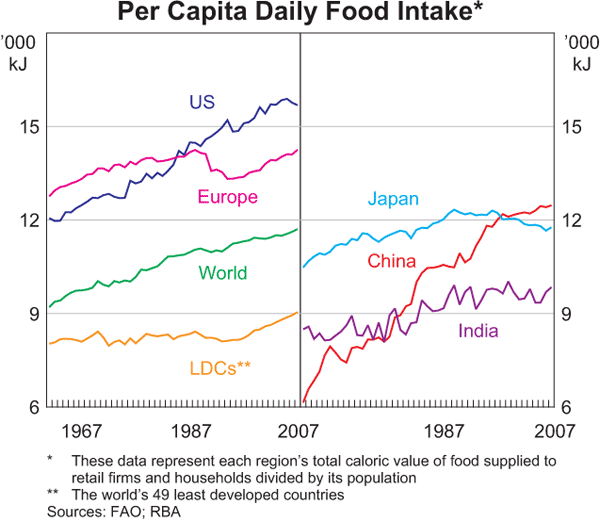
As another simple illustration of these patterns, Graph 5 uses cross-country data from 2007 to examine the relationship between income and food consumption. Trend lines are obtained from estimating a relationship between the log levels of gross national income and consumption of grains, sugar and meat for 158 countries. The results show that per capita consumption of meat and sugar increases with income and tends to stabilise at high income levels, whereas grains consumption shows little tendency to increase with income. Nevertheless, an implication of rising meat demand is that demand for grains as an intermediate input to livestock production (i.e. feed) is likely to rise with income.
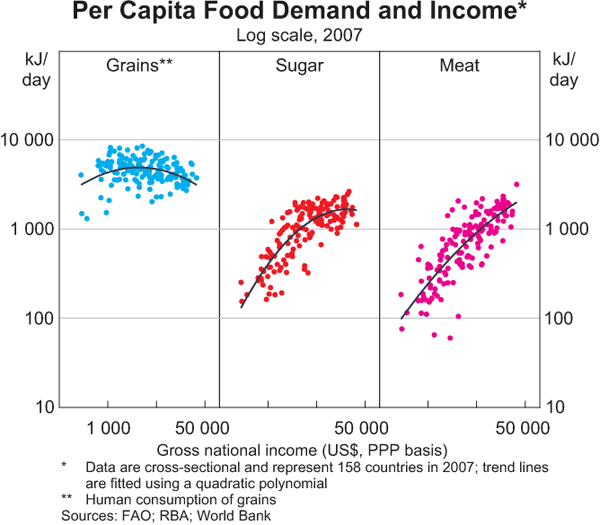
Some rural commodities are also used as intermediate inputs into biofuel production. The production of ethanol and biodiesel – the two main biofuels – requires agricultural inputs such as sugar cane, vegetable oils and corn. Biofuel production has increased rapidly over the past decade, largely in response to high energy prices and government mandates and subsidies. Strong demand for agricultural inputs into biofuel production has been cited as a factor behind the rise in food prices in the years leading up to 2007/08, with record high oil prices increasing the economic viability of this alternative energy source and encouraging farmers to shift plantings towards biofuel feedstocks (see for example FAO (2009) and Mitchell (2008)) (Graph 6). The global financial crisis resulted in some slowing in the growth of biofuel production, with lower energy prices weighing on the profitability of biofuel plants and delaying investment. However, the OECD-FAO (2010) notes that renewed firmness in energy prices since the second half of 2009 has been associated with the enforcement of higher biofuel blending obligations in some countries, resulting in greater demand and higher world prices for feedstocks, ethanol and biodiesel. Consistent with this, almost 40 per cent of US corn production is estimated to be used in ethanol production in 2010/11 (Graph 7).
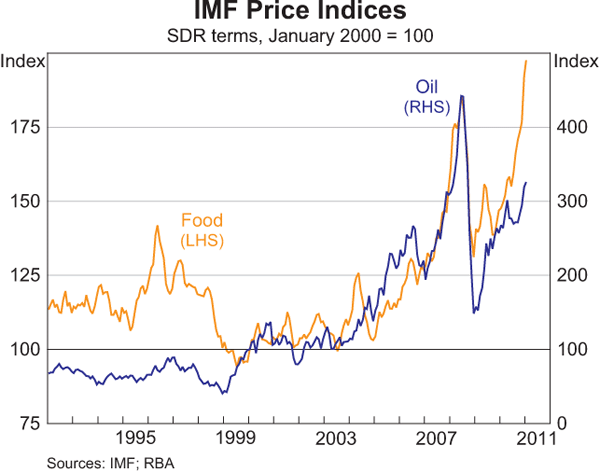
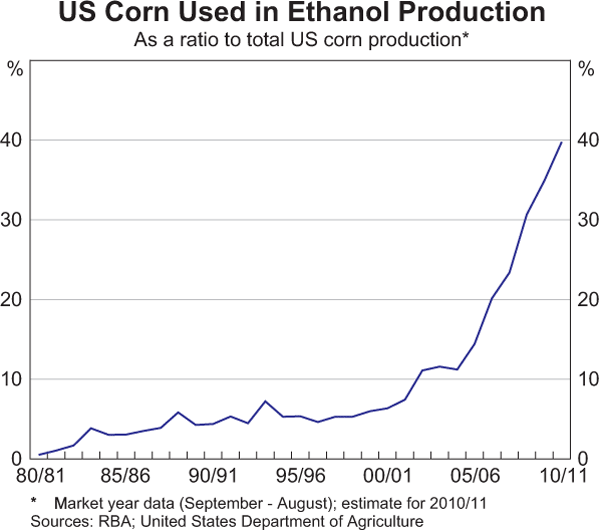
Supply-side Developments
Growth in food supply is driven by changes in the area of land dedicated to crop and livestock production as well as changes in production yields. While productivity changes are an important driver of yields over the long run, yields in the short run can be significantly affected by temporary weather events such as droughts, floods or cyclones. Weather-related disturbances in a number of key food-producing countries have contributed to large price increases for a broad range of agricultural commodities over the past couple of years, most notably wheat, sugar, corn and oilseeds (for example, soybeans) (Graph 8). However, it is important to note that these commodities are not homogenous and price movements observed in local markets may vary because of differences in quality or barriers to trade such as tariffs.
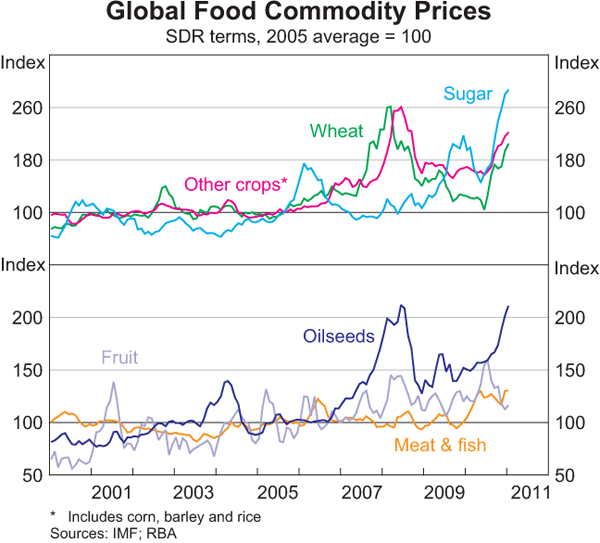
Wheat prices have risen sharply over the past year, partly in response to unfavourable weather conditions in major wheat-producing countries. Yields in Canada have been affected by heavy rains and frost, while dry conditions in Europe and drought in the Black Sea region have weighed further on global production (Canada, Europe and countries in the Black Sea region have recently accounted for over one half of global wheat exports). Heavy rains and flooding in eastern Australia and dry conditions in Western Australia have affected the quality of the Australian harvest and, more recently, concerns that dry winter conditions in China may affect domestic production also supported wheat prices. Barley production has been affected by similar weather conditions as wheat, and poor weather conditions in the United States have resulted in lower corn yields, with the USDA revising down its forecast for US corn stocks to a 15-year low in 2010/11.
Sugar prices have been particularly volatile over the past two years, also partly reflecting weather-related disruptions. Global sugar stocks declined to low levels in 2009 following poor harvests in Brazil and India (these two countries accounted for nearly 40 per cent of global production in recent years). The subsequent fall in sugar prices in early 2010 reflected higher production in Brazil, as well as slower growth in demand for ethanol during the global financial crisis. Sugar prices picked up again in the second half of 2010, initially reflecting supply disruptions in Brazil, as well as a delay in the annual sugar crush in Queensland due to wet weather (Australia was the world's third largest sugar exporter in 2009). Global stock levels are expected to remain tight in 2011/12, with Cyclone Yasi having affected Australia's 2011/12 sugar crop.
Prices of oilseeds have also risen in response to projections of lower supply in 2010/11, with dry conditions in Argentina lowering expectations of area planted to soybeans and production yields. This follows price increases in previous years, owing to supply shortfalls in the 2007/08 and 2008/09 seasons and a delayed crop in South America in 2009/10 (even though the latter turned out to be the largest crop on record). Meat prices have increased as farmers seek to rebuild herds, and rising grain prices are also likely to contribute to higher grain-fed beef prices.
While weather developments can affect short-term production yields, long-run trends in yields are mainly influenced by changes in farm productivity. Productivity growth in the grains sector was relatively high from the 1960s to 1980s, with most of the increase in world crop production attributable to higher yields rather than increases in cropping area (Graph 9). This rise in productivity was largely due to the ‘Green Revolution’, which included the development of improved seed and high-yielding grain varieties, synthetic fertilisers, pesticides and the expansion of irrigation infrastructure. Green Revolution techniques were adopted in the developed world and parts of developing Asia, but considerable potential still exists for extending these productivity gains to other regions, particularly in Africa, Europe and Central Asia (IBRD/World Bank 2009). In many developing economies, agriculture remains very labour intensive and access to modern technology, infrastructure, non-labour inputs, transport and credit is limited; as a result, supply-side constraints can prevent farmers from increasing production in response to higher prices or favourable weather conditions.

Crop productivity growth slowed in the 1990s and 2000s, with gains from the Green Revolution fading and declining relative food prices providing less incentive to invest in productivity improvements. Notably, some commentators partly associated lower productivity growth during this time with a slowdown in the rate of growth in public investment in agricultural research and development (Alston, Beddow and Pardey 2009). More recently, yields have increased in some countries following the introduction of genetically modified crops, but concerns about the environment, food safety and property rights have constrained broad-based adoption of these crop varieties (IBRD/World Bank 2009).
Implications for Inflation
The rise in agricultural commodity prices is contributing to higher consumer price inflation in a number of countries. Most notably, higher food prices are placing upward pressure on headline inflation in several east Asian economies, including China, South Korea and Indonesia. In general, however, food price inflation across the region is yet to reach the highs experienced in mid 2008, and in Taiwan, the Philippines and Malaysia food price inflation is still at or below long-run average rates (Graph 10). Similarly, food price inflation in the United States and United Kingdom has drifted higher over the past year, but at this stage remains well below their respective peaks in mid 2008.
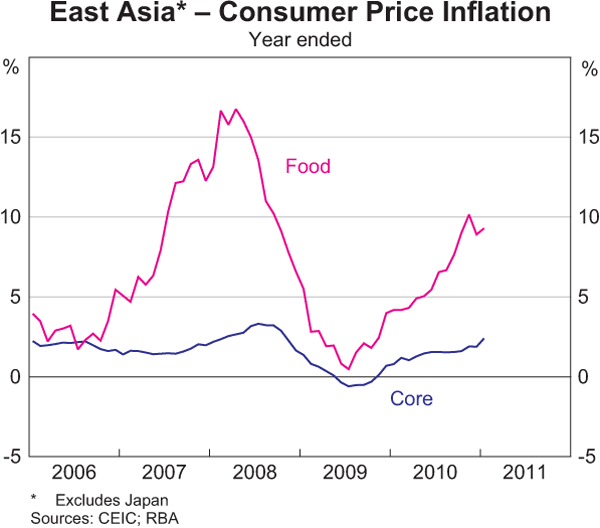
Some countries have taken direct measures to ensure adequate domestic food supplies and contain inflation. Drought caused some countries in the Black Sea region, namely Russia and Ukraine, to impose export restrictions on grains until the end of June 2011. The Chinese Government has introduced an anti-inflation plan, part of which is aimed at encouraging local governments to promote the supply of fresh vegetables and grains to stabilise prices. The plan includes higher penalties for speculation and hoarding, and measures to increase the supply of fertilizer and improve supply-chain logistics for agricultural products.
Interestingly, food price inflation in Australia has, to date, been relatively modest (Graph 11). Excluding fruit and vegetable prices, food prices increased by only 1.6 per cent over 2010. The appreciation of the exchange rate has, to some extent, moderated imported food price inflation and domestic retail competition has also played a role. Nonetheless, it is expected that higher world prices for commodities such as wheat and sugar will place upward pressure on related food prices. Recent flooding in Queensland and Cyclone Yasi are also pushing up food prices, particularly for fresh fruit and vegetables, although most of this effect is likely to unwind as supply recovers.
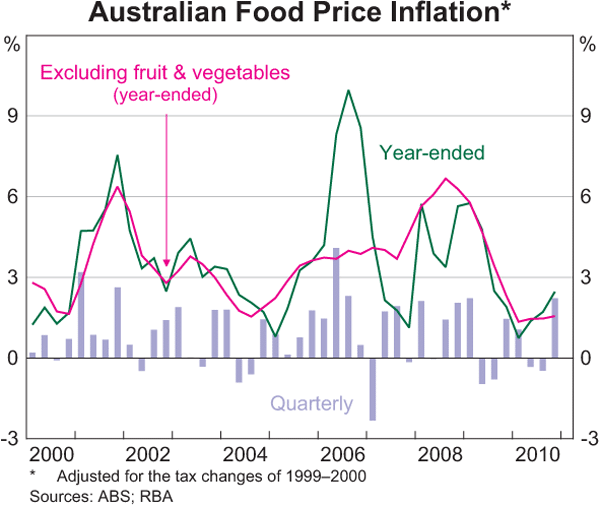
While core inflation has begun to rise in those countries experiencing high food price inflation, it remains relatively contained at this stage. However, a potential concern if food prices continue to rise is that consumers may come to expect higher inflation on an ongoing basis and adjust their behaviour accordingly. This is more likely to be an issue in developing countries, where food makes up a larger share of households' consumption basket (Graph 12).
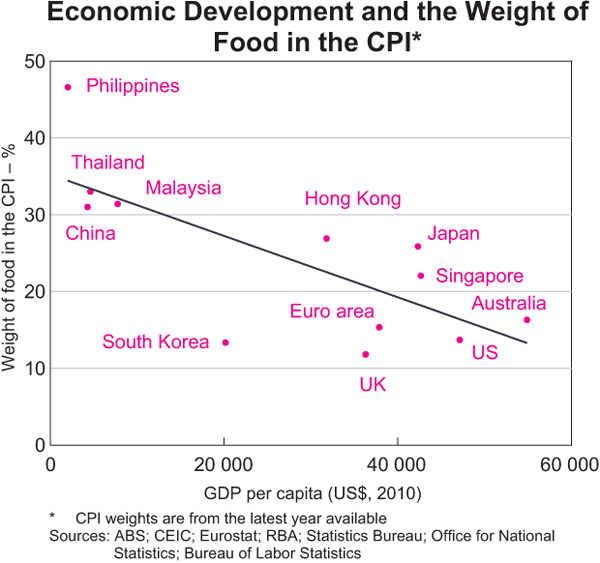
Given that unfavourable weather developments have been a factor behind the recent spike in food prices, it is possible that the rate of food price inflation could moderate fairly quickly. Under this scenario, a sharp, temporary rise in food prices should have no long-term effect on inflation expectations. Still, in the medium to long run, it is likely that food prices will remain at a relatively high level given ongoing strong demand. In fact, the OECD-FAO (2010) projects that most crop and livestock prices over the next 10 years (in real and nominal terms) will exceed the average levels of the decade prior to the 2007/08 peaks, underpinned by an increasingly high-cost structure, strong demand from developing countries, continued expansion of biofuel production and slower growth in agricultural production. While monetary policy cannot affect the long-term relative price of food, the challenge for central banks in these circumstances is to keep the general level of prices contained and inflation expectations well anchored.
Footnote
The authors are from Economic Group. [*]
References
Alston J, J Beddow and P Pardey (2009), ‘Mendel Versus Malthus: Research, Productivity and Food Prices in the Long Run’, University of Minnesota Department of Applied Economics Staff Papers Series, Staff Paper P09-1.
FAO (Food and Agriculture Organization of the United Nations) (2009), The State of Agricultural Commodity Markets: High Food Prices and the Food Crisis: Experiences and Lessons Learned, FAO, Rome.
IBRD (International Bank for Reconstruction and Development)/World Bank (2009), Global Economic Prospects 2009: Commodities at the Crossroads, The World Bank, Washington DC.
Mitchell, D (2008), ‘A Note on Rising Food Prices’, World Bank Policy Research Working Paper No 4682.
OECD-FAO (Organisation for Economic Co-operation and Development and the Food and Agriculture Organization of the United Nations) (2010), OECD-FAO Agricultural Outlook 2010-2019, OECD Publishing, Paris.